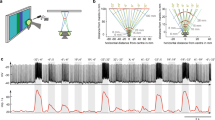Abstract
HARKNESS'S demonstration1 that chameleons rely primarily upon accommodative cues to judge distance encouraged me to examine the mechanisms of depth vision in an amphibian (Bufo marius). Unlike chameleons which have highly mobile eyes, toads make neither convergent nor fixating eye movements, so that, except for stabilising reflexes, their eyes are almost locked in their sockets2. For simple forms of stereoscopic range finding it is an advantage to have immobile eyes because disparity measurements can be converted directly into estimates of absolute depth (Fig. 1a). One might therefore expect toads to use retinal disparity in judging the distance of their prey. Toads have the essential apparatus for stereopsis: there is a substantial binocular overlap both in front of and above the animal3, the interocular distance is relatively large, and neural pathways bring information from corresponding areas on the two retinae to the same region in both mid-brain4 and thalamic5 visual areas. My results suggest that toads do indeed make disparity measurements and should be added to the growing list of vertebrates known to achieve stereopsis (monkey6, cat7, owl8). In addition, toads have a mechanism for measuring depth within their extensive monocular field. Ingle has shown9 that frogs and toads, like chameleons, can estimate the distance of prey almost as well with one eye as with two, and the present data suggest that they do this by monitoring the accommodative state of their eyes when the prey is in optimum focus, as Ingle originally proposed10.
Similar content being viewed by others
References
Harkness, L. Nature 267, 346–349 (1977).
Grüsser, O.-J. & Grüsser-Cornehls, U. in Frog Neurobiology (eds R. Llinas & W. Precht) (Springer, Berlin, 1976).
Fite, K. V. Behav. Biol. 9, 707–718 (1973).
Gaze, R. M. & Jacobson, M. Q. Jl exp. Physiol. 47, 273–280 (1962).
Keating, M. J. & Kennard, C. J. Physiol., Lond. 258, 69–70P (1976).
Bough, E. Nature 225 42–44 (1970).
Fox, R. & Blake, R. R. Nature 253, 55–56 (1971).
Pettigrew, J. D. & Konishi, M. Science 193, 675–678 (1976).
Ingle, D. in The Amphibian Visual System (ed. K. V. Fite) (Academic, New York, 1976).
Ingle, D. Brain Behav. Evol. 1, 500–518 (1968).
Author information
Authors and Affiliations
Rights and permissions
About this article
Cite this article
COLLETT, T. Stereopsis in toads. Nature 267, 349–351 (1977). https://doi.org/10.1038/267349a0
Received:
Accepted:
Issue Date:
DOI: https://doi.org/10.1038/267349a0
- Springer Nature Limited
This article is cited by
-
Optic flow based spatial vision in insects
Journal of Comparative Physiology A (2023)
-
An interhemispheric neural circuit allowing binocular integration in the optic tectum
Nature Communications (2019)
-
Investigating the role of body size, ecology, and behavior in anuran eye size evolution
Evolutionary Ecology (2019)
-
Vergleichende Betrachtung von Lichtempfindlichkeit, Tiefenwahrnehmung und Bewegungswahrnehmung bei Tier und Mensch
Der Ophthalmologe (2017)
-
Insect stereopsis demonstrated using a 3D insect cinema
Scientific Reports (2016)





